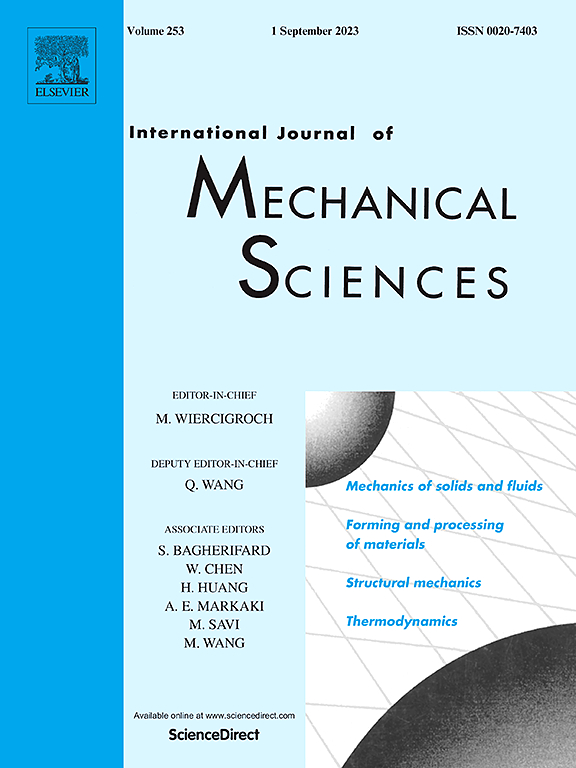Fracture mechanics analysis of auxetic chiral materials
IF 7.1
1区 工程技术
Q1 ENGINEERING, MECHANICAL
International Journal of Mechanical Sciences
Pub Date : 2025-04-15
DOI:10.1016/j.ijmecsci.2025.110281
引用次数: 0
Abstract
Auxetic materials sometimes exhibit extremely high strength, stiffness and toughness, such as limpet tooth. The toughening mechanism of such materials is still not completely clear. This paper first theoretically derives the crack-tip asymptotic fields of a planar auxetic chiral solid. It can be found that the planar auxetic chiral solid has three crack modes, i.e., the opening mode governed by the mode I force stress intensity factor (FSIF), the sliding mode governed by the mode-II FSIF and the local bending mode governed by the couple stress intensity factor (CSIF), and these crack modes are generally coupled with each other. The microstructural auxeticity induces asymmetric distributions of the angular functions in the mode I and mode II cracks. Local bending deformation is likely to induce the occurrence of stepped crack paths in auxetic chiral materials observed experimentally in available literature. Then, a new interaction integral (I-integral) method is established to decouple the mode-I FSIF, the mode-II FSIF and the CSIF. The proposed I-integral has two extra superiorities over the J-integral: (i) it does not require the derivatives of material parameters; (ii) it is domain-independent for material interfaces, which is theoretically proved and numerically validated. With these two features, the proposed I-integral becomes a powerful tool in decoupling the FSIFs and CSIF for nonhomogeneous and multi-interface auxetic chiral materials. Numerical simulations on the fracture of limpet teeth indicate that the tensile-torsional coupling deformation of microstructures can reduce the risk of mode I fracture of auxetic chiral materials. The chirality angle affects both the FSIFs and CSIFs significantly.

缺乏手性材料的断裂力学分析
辅助材料有时表现出极高的强度、刚度和韧性,如帽贝齿。这类材料的增韧机理尚不完全清楚。本文首先从理论上导出了平面缺手性固体的裂纹尖端渐近场。研究发现,平面auxetic手性固体具有三种裂纹模式,即由I型力应力强度因子(FSIF)控制的开启模式、由ii型FSIF控制的滑动模式和由耦合应力强度因子(CSIF)控制的局部弯曲模式,并且这些裂纹模式通常相互耦合。显微组织的形变性导致I型和II型裂纹的角函数分布不对称。在已有的实验研究中,观察到局部弯曲变形可能导致缺失性手性材料出现阶梯裂纹路径。然后,建立了一种新的相互作用积分(i积分)方法来解耦i型FSIF、ii型FSIF和CSIF。与j积分相比,所提出的i积分有两个额外的优点:(i)它不需要材料参数的导数;(ii)材料界面是域无关的,理论证明和数值验证了这一点。由于这两个特点,所提出的i积分成为解耦非均匀多界面辅助手性材料的fsif和CSIF的有力工具。对帽贝齿断裂的数值模拟表明,微观组织的拉扭耦合变形可以降低缺乏手性材料的I型断裂风险。手性角对FSIFs和CSIFs均有显著影响。
本文章由计算机程序翻译,如有差异,请以英文原文为准。
求助全文
约1分钟内获得全文
求助全文
来源期刊

International Journal of Mechanical Sciences
工程技术-工程:机械
CiteScore
12.80
自引率
17.80%
发文量
769
审稿时长
19 days
期刊介绍:
The International Journal of Mechanical Sciences (IJMS) serves as a global platform for the publication and dissemination of original research that contributes to a deeper scientific understanding of the fundamental disciplines within mechanical, civil, and material engineering.
The primary focus of IJMS is to showcase innovative and ground-breaking work that utilizes analytical and computational modeling techniques, such as Finite Element Method (FEM), Boundary Element Method (BEM), and mesh-free methods, among others. These modeling methods are applied to diverse fields including rigid-body mechanics (e.g., dynamics, vibration, stability), structural mechanics, metal forming, advanced materials (e.g., metals, composites, cellular, smart) behavior and applications, impact mechanics, strain localization, and other nonlinear effects (e.g., large deflections, plasticity, fracture).
Additionally, IJMS covers the realms of fluid mechanics (both external and internal flows), tribology, thermodynamics, and materials processing. These subjects collectively form the core of the journal's content.
In summary, IJMS provides a prestigious platform for researchers to present their original contributions, shedding light on analytical and computational modeling methods in various areas of mechanical engineering, as well as exploring the behavior and application of advanced materials, fluid mechanics, thermodynamics, and materials processing.
 求助内容:
求助内容: 应助结果提醒方式:
应助结果提醒方式:


